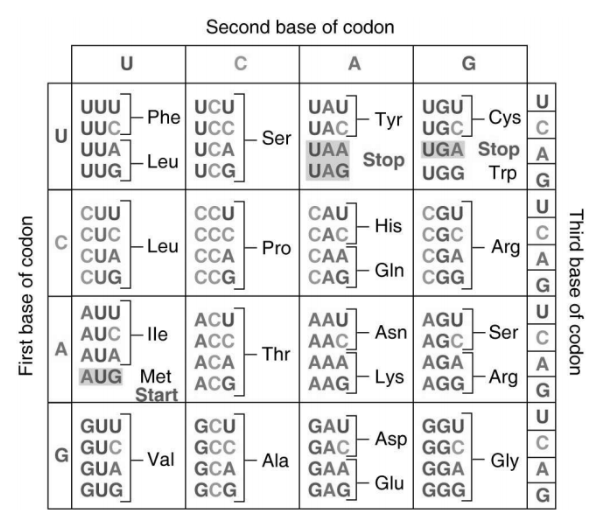For the following strand of DNA, use the table below to provide: bases for the complementary mRNA and bases for the corresponding tRNA molecules and the associated amino acids. What do you notice about the relationship between the DNA and the anticodons? What do you notice about the genetic code for proline in the peptide? How would the loss of the first G or switching that G to a T affect the
structure and function of this protein?
DNA: GGC CTA CAA GCC GGA ACA GTT ACC GCG TAA CGA
mRNA:
tRNA:

mRNA: CCG GAU GUU CGG CCU UGU CAA UGG CGC AUU GCU
tRNA: GGC CUA CAA GCC GGA ACA GUU ACC GCG UAA CGA
protein: pro asp val arg pro cys gln trp arg ile ala
The DNA triplets and the tRNA anticodons are identical except that U (in tRNA) substitutes for T (in DNA). In this
peptide, proline was specified by two different codons, CCG and CCU.
1 base lost: arg met phe gly leu val asn gly ala leu
1 base altered: thr asp val arg pro cys gln trp arg ile ala
Loss of a base results in dramatic changes in the protein structure (1 less amino acid and a start codon at the second
codon) which means the proteins is unlikely to be functional. However, a single base substitution would have a
single amino acid different which make the proteins more likely to be functional although the function may still be
altered.
You might also like to view...
In ______ muscle, muscle impulses pass freely from cell to cell, resulting in contraction of the entire muscle, not just individual fibers.
Fill in the blank(s) with correct word
Digital means fingers and toes
Indicate whether the statement is true or false.
Which of the following is an accurate statement regarding multiple organ dysfunction system?
a. It has a mortality rate of 5% to 50% b. It involves four or more organ systems c. It is an uncommon cause of death in the ICU setting d. It is often caused by sepsis
Sympathetic stimulation of the heart will ________.
A. increase conduction rate between the SA and AV nodes B. increase the rate of depolarization in the ventricles C. increase the strength of myocardial contraction D. All of the choices are correct.